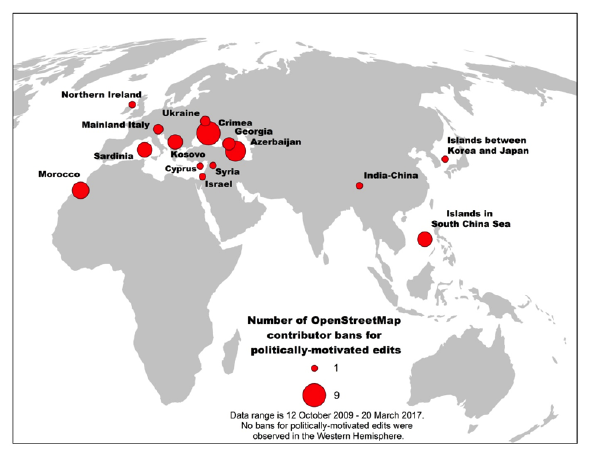When two countries or peoples disagree on boundaries or place names, whose point of view prevails on the map? Many of the online maps we see today are produced by big tech firms, who have a business interest in operating internationally, sometimes in both places involved in a geopolitical dispute. Other maps are made by crowdsourced volunteers who engage in edit wars or rogue updates to the map to advance a geopolitical cause.
Some online map producers have publicly explained how they address disputes. Stated approaches have included referencing international standards bodies, appealing to ground truth, and favoring local preference; however, online map producers have sometimes violated their own guidelines in two ways:
- Creating multiple versions of the map to satisfy map readers in different locales. For example, the Chinese localization of Google Maps shows the ten-dashed line encircling the South China Sea, whereas the default version of Google Maps shown in the US does not show this line. Gary Soeller and others built a tool that detected multiple instances of this type of customization in Google Maps and Bing Maps.In crowdsourced maps, contributors may apply “rogue customizations” with their own preferred boundaries or names that do not reflect current sovereignty or local usage. These persist in the map until being caught by other contributors. The map below shows places where OpenStreetMap contributors have made politically-motivated edits resulting in ban actions from the project’s Data Working Group.

Map by Sterling Quinn with data processing assistance by Floyd Bull.
- Introducing ambiguity into the map by selectively adding or removing information. For example, to skirt controversy, there were periods when the Persian/Arabian Gulf was removed from Google Earth and the name of Jerusalem was removed from OpenStreetMap. In other cases, two names for the same entity have been applied side by side, such as Derry and Londonderry. Even boundaries can be ambiguous: OpenStreetMap still displays Crimea as belonging to both Russia and Ukraine.
In an open-access article in the Internet-studies journal First Monday, Doran Tucker and I offer further examples and literature describing the above customization and ambiguity practices, while also discussing some of their long-term implications and relationships to power. We argue that when it comes to making political maps, online producers prioritize their own missions above commitments to arrive at ground truth. In the end, we caution that the lines and text on geopolitical online maps should be viewed as a patchwork of decisions that reflect the values and interests of the map makers across different extents.
